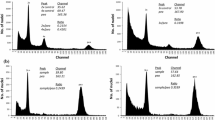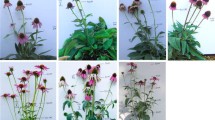Abstract
Populations of apomictic seedlings of clones ofCitrus species,Citrus hybrids, andPoncirus in the sub-family Aurantioideae were examined for spontaneous tetraploids as a source of materials for use in breeding experiments. Diagnostic features found useful in identifying nucellar tetraploids were leaf shape, petiole blade shape, leaf blade thickness, leaf color, comparative size differences in leaf venation, oil glands, and stomata, stem thickness, and relative size and developmental pattern of the root system. In older or bearing-age plants, nucellar tetraploids may be identified by differences in growth habit, vigor, size, time of growth initiation and bloom, and flower and fruit characteristics. Data are given for tetraploid frequency in glasshouse-grown, first-year nucellar seedlings of 42 populations of 32 clones of different genetic and seed origin and for tetraploid frequency in commercialnursery nucellar seedlings of the Carrizo rootstock clone in two consecutive years. Comparative data are given for quantitative development of roots, stems, and leaves of tetraploids and similar diploid nucellar seedlings. The data suggest that the ability to produce tetraploid apomictic seedlings is a variable genetic trait present in all or nearly all clones able to reproduce by adventitious embryony. Aspects of tetraploid nucellar seedlings that might warrant their testing as tree-size-controlling rootstocks in commercial citrus growing are discussed.
Similar content being viewed by others
Literature cited
Barrett, H. C. 1974. Colchicine-induced polyploidy inCitrus. Bot. Gaz.135(1): 29–41.
Cameron, J. W. andR. K. Soost. 1969. Characters of new populations ofCitrus polyploids, and the relation between tetraploidy in the pollen parent and hybrid tetraploid progeny. Pages 199-250in Proc. First Intern. Citrus Symp., March 1968. Vol. 1. Univ. of Calif. Press, Riverside.
Dyer, A. F. 1963. The use of lacto-propionic orcein in rapid squash methods for chromosome preparations. Stain Technol.38: 85–90.
Frost, H. B. 1925. Tetraploidy in citrus. Proc. Nat. Acad. Sci.11:535–537.
—1926. Polyembryony, heterozygosis and chimeras in citrus. Hilgardia1: 365–402.
—1943. Genetics and breeding. Pages 817-913in The Citrus Industry, Vol. 1. Univ. of Calif. Press, Berkeley.
—andC. A. Krug. 1942. Diploid-tetraploid periclinal chimeras as bud variants in citrus. Genetics27: 619–634.
Furusato,K. 1953a. Tetraploidy in citrus. Annual Rep. Nat. Inst. Genet. (Japan)3: 51–52.
—1953b. Abnormal growth of citrus trees caused by deviating chromosome numbers in the grafting stocks. Annual Rep. Nat. Inst. Genet. (Japan)3: 52–53.
Iwasa,S. andS.Shiraishi. 1957. Studies on the trifoliate orange. I. Strains found inPoncirus trifoliata Raf. Studies Inst. Hort. Kyoto Univ.8: 59–63.
Lapin, W. K. 1937. Investigations on polyploidy in citrus (in Russian, English summary). USSR AUUnion Sci. Res. Inst. Humid Subtropics Workshop1(4): 1–68.
Mukherjee, S. K. andI. W. Cameron. 1958. Tree size and chromosome number in a trial of tetraploid trifoliate orange as a citrus rootstock. Proc. Amer. Soc. Hort. Sci.72: 267–272.
Nakamura,M. 1942. Cytological studies in theCitrus. III. Further data on the chromosome numbers. J. Hort. Assoc. (Japan)13: 30–40. Tokyo.
Russo,F. andM. Torrisi 1951. Forme tetraploidi inCitrus limon (L.) Burm. f. eaurantium L. Ann. Sper. Agr. (Rome)5: 13–20.
Soost, R. K. andI. W. Cameron 1969. Tree and fruit characters ofCitrus triploids from tetraploid by diploid crosses. Hilgardia39: 569–579.
Storey, W. B. andI. D. Mann 1967. Chromosome contraction by o-isopropyl-N-phenylcarbamate (IPC). Stain Technol.42: 15–18.
Tachikawa,T., Y. Tanaka, andS. Hara 1961. Investigations on the breeding of citrus trees. I. Study on the breeding of triploid citrus varieties. Bull. Shizuoka Citrus Exp. Sta.4: 33–44.
Webber, H. J. 1948. Rootstocks: their character and reactions. Pages 69-168in The Citrus Industry, Vol. 11, Univ. of California Press, Berkeley.
Author information
Authors and Affiliations
Rights and permissions
About this article
Cite this article
Barrett, H.C., Hutchison, D.J. Spontaneous tetraploidy in apomictic seedlings ofCitrus . Econ Bot 32, 27–45 (1978). https://doi.org/10.1007/BF02906727
Received:
Accepted:
Issue Date:
DOI: https://doi.org/10.1007/BF02906727




